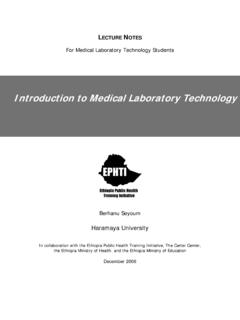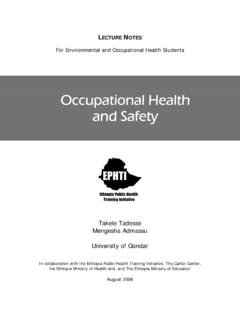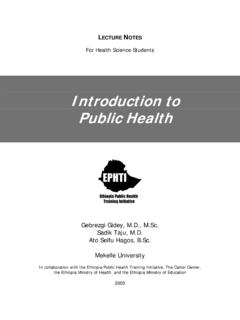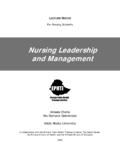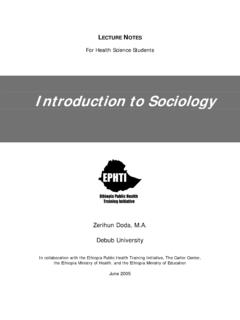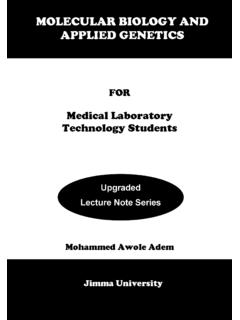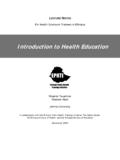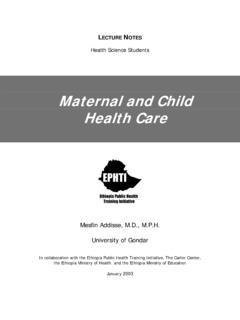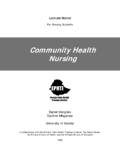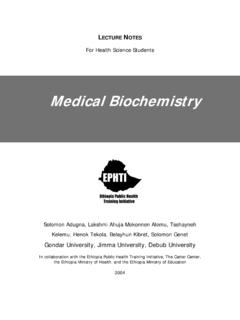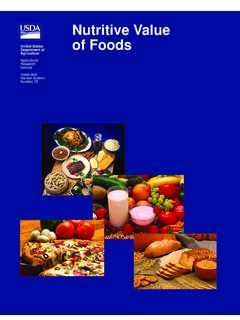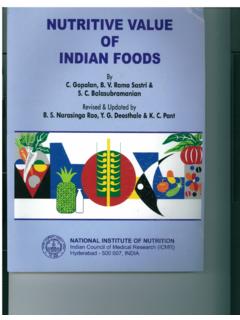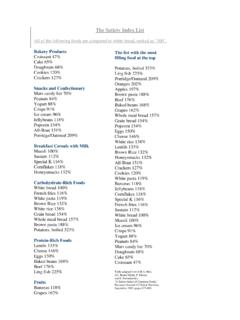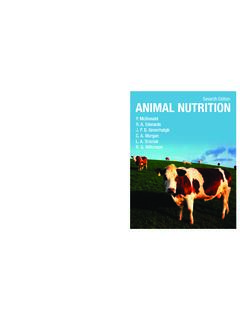Transcription of LECTURE NOTES - Carter Center
1 LECTURE NOTES . Nutrition For Health Extension Workers Melkie Edris Debub University In collaboration with the Ethiopia Public Health Training Initiative, The Carter Center , the Ethiopia Ministry of Health, and the Ethiopia Ministry of Education November 2004. Funded under USAID Cooperative Agreement No. 663-A-00-00-0358-00. Produced in collaboration with the Ethiopia Public Health Training Initiative, The Carter Center , the Ethiopia Ministry of Health, and the Ethiopia Ministry of Education. Important Guidelines for Printing and Photocopying Limited permission is granted free of charge to print or photocopy all pages of this publication for educational, not-for-profit use by health care workers, students or faculty. All copies must retain all author credits and copyright notices included in the original document.
2 Under no circumstances is it permissible to sell or distribute on a commercial basis, or to claim authorship of, copies of material reproduced from this publication. 2004 by Melkie Edris All rights reserved. Except as expressly provided above, no part of this publication may be reproduced or transmitted in any form or by any means, electronic or mechanical, including photocopying, recording, or by any information storage and retrieval system, without written permission of the author or authors. This material is intended for educational use only by practicing health care workers or students and faculty in a health care field. Acknowledgments The development of this LECTURE note for training Health Extension workers is an arduous assignment for Ato Melkie Edris at University of Gondar Essentially, it required the consolidation and merging of existing in depth training materials, examination of Health Extension Package manuals and the Curriculum.
3 Recognizing the importance of and the need for the preparation of the LECTURE note for the Training of Health Extension workers THE Carter Center (TCC) ETHIOPIA. PUBLIC HEALTH TRAINING INITIATIVE (EPHTI) facilitated the task for University of Gondar to write the LECTURE note in consultation with the Health Extension Coordinating Office of the Federal Ministry of Health. Finally the Federal Ministry of Health would like to express special words of gratitude for those who contributed and endeavored to the development of this LECTURE note and to TCC/USAID for the technical and financial support. -i- Table of Contents Topics Page Acknowledgement .. i Table of Contents .. ii List of Tables .. iii Abbreviation .. iv Introduction ..1. UNIT ONE: General Nutrition.
4 3. UNIT TWO: Carbohydrates ..12. UNIT THREE: Proteins ..19. UNIT FOUR: Lipids ..29. UNIT FIVE: Basal Metabolism ..35. UNIT SIX: Vitamins ..38. UNIT SEVEN: Mineral Salts ..58. UNIT EIGHT: Water ..67. UNIT NINE: Growth and Development ..72. UNIT TEN: Nutritional Surveillance ..79. UNIT ELEVEN: Nutrition Intervention ..81. UNIT TWELVE: Essential Nutrition Actions Approach ..84. Reference ..90. - ii - List of Tables Tables Pages Table 1. Carbohydrate Content of some food ..15. Table 2. Summary of Carbohydrate digestion ..16. Table 3. Summary of protein digestion ..21. Table 4. Vitamin A content of foods of animal Table 5. Vitamin A content of foods of plant Table 6. Identification of vitamin A deficiency at the community of Table 7. Body water components in the reference Table 8.
5 Water low - iii - Abbreviations ABCD = Anthropometry biochemical clinical and dietary methods AIDS = Acquired Immuno Deficiency syndrome BMR = Basal Metabolic Rate CO2 = Carbon Dioxide EAA = Essential Amino Acids EBF = Exclusive Breast Feeding ENA = Essential Nutrition Actions EPI = Expanded Program of Immunization FP = Family Planning GDP = Gross domestic product GMP = Growth Monitoring Programme HDL= High Density Lipoprotein HFA = Height For Age HIV = Human Immuno Deficiency Virus IDD = Iodine Deficiency Disorder IEC = Information, Education and Communication IMCI = Integrated management of Child Illness LBW= Low birth weight LDL = Low Density Lipoprotein NSI = Nutrition Surveillance Information PEM = Protein Energy Malnutrition PMTCT = Prevention Mother to Child Transmission PUFA= Poly Unsaturated Fatty Acids RDI = Required Dietary Intake STI = Sexual Transmitted Infections TWS = Timely warning system WFH = Weight For Height - iv - Nutrition Introduction Many children do not get enough of the right food to eat.
6 They do not grow well, they become ill, many die or they do not grow up as clever, as healthy. Causes and consequences of poor nutrition are better understood now, and so are the ways to prevent and manage it. Low food intake and infections are the immediate causes of malnutrition. The underlying causes are insufficient household food security, inadequate childcare and insufficient basic health services in the community. It includes poor living conditions, lack of education, heavy physical work, and frequent childbearing. And the basic causes are economic structure, political and ideological superstructure. The mortality among preschool children is extremely high in developing countries in general and in Ethiopia in particular. It is quite clear that malnutrition in combination with infection, more often than not is, the cause of high morbidity and mortality in Ethiopia.
7 Micronutrient deficiencies such as vitamin A, iodine and iron are the most prevalent in Ethiopia and it affects mothers and children at large. The entire efforts in the preparation of this LECTURE note require that the elements of nutrition should be understood by Health Extension 1. Nutrition Students and their Instructors for the implementation of nutrition interventions. 2. Nutrition UNIT ONE. General Nutrition Learning objectives At the end of this unit, students will be able to: Define food , Nutrition, Diet and Malnutrition Understand best practices and harmful traditions, which affect nutrition, Explain the dietary guidelines, Outline the important causes of malnutrition, 3. Nutrition Definitions food : - is defined as any solid or liquid which when ingested will enable the body to carry out any of its life function.
8 Most foods are made up of several simple substances, which we call nutrients. There are six nutrients each of which has specific function in the body. Those that supply energy are the carbohydrates and fats. Those responsible for growth and repair of tissues cells are proteins. Those, which regulate chemical process in the body, are the vitamins and minerals. Water is present in most foods and is an indispensable component of our bodies. It is the means of transportation for most nutrients and is needed for all cellular activities. Nutrition: - is the sum total of the process by which living things receive and utilize the necessary materials for survival, growth and maintenance of worn out tissues. Malnutrition: - is the condition that results from an imbalance between dietary intake and requirements.
9 It includes under nutrition, which results from less food intake and hard physical work and over nutrition results from excess food intake and less physical activities. Diet: - is defined as food containing all the nutrients in a sufficient amount and in proper ratio. 4. Nutrition Roughage: - is defined as food fibres which enable the body to get rid of waste products, which would otherwise become poisonous to the body. It prevents gastrointestinal disorders (gastritis, appendicitis, gallbladder stone and constipation) and metabolic disorders (diabetes mellitus, hypertension, ischemic heart disease and colon cancer). Dietary guidelines Eat a wide variety of foods Maintain healthy weight Choose a diet low in fat, saturated fat, and cholesterol Choose a diet with plenty of vegetable, fruits and grain products Use sugar in moderation Use salt and sodium in moderation If you drink alcoholic beverage, do so in moderation.
10 food groups Milk, cheese, yoghurt Meat, poultry, fish and alternates Fruits and vegetables Bread and cereals Fats, sweets and alcohols 5. Nutrition Why human beings need food ? Human beings need food to provide energy for the essential physiological functions like:- Respiration Circulation Digestion Metabolism Maintaining body temperature. Growth and repair body Tissues An adequate supply of nutrients is needed to maintain all the functions of the body and daily activities at maximum efficiency, thus ensuring healthy living. Health and nutrition are closely linked and to ensure proper development and life quality they must be adequate from early childhood on and most vulnerable groups are infants, young children, pregnant women and lactating mothers.
